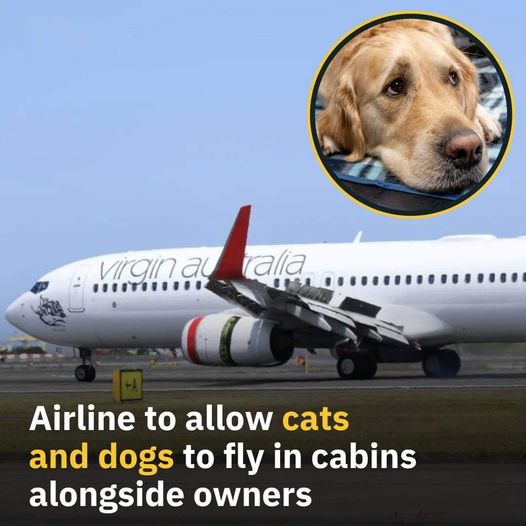
Pets are often more than just animals—they’re part of the family. Leaving them behind during vacations can be heartbreaking, especially for those who rely on their pets. For many, the idea of traveling without their furry companions is simply unimaginable.
 In the past, pets traveling by plane were typically checked in, placed in cages, and transported in the cargo area. They would then be retrieved at the baggage claim upon arrival. Although incidents are rare, families often worry about their pets traveling as cargo, fearing they may feel scared or disoriented.
In the past, pets traveling by plane were typically checked in, placed in cages, and transported in the cargo area. They would then be retrieved at the baggage claim upon arrival. Although incidents are rare, families often worry about their pets traveling as cargo, fearing they may feel scared or disoriented.
For some individuals, pets are more than just companions—they’re lifesavers. Service animals can detect low blood sugar, alert to seizures, or sense cardiac issues. For these people, having their pets by their side is crucial for their own safety. The demand for allowing pets in the cabin has grown, and by the end of 2023, over 20 airlines worldwide opened their cabins to pets.
Airlines such as Air Canada, French Bee, TAP Air Portugal, Delta, Lufthansa, and United Airlines allow pets in the cabin, but each has its own requirements. These often involve restrictions on the pet’s breed, size, and age. For instance, some airlines require puppies to be at least eight weeks old, while others set the limit at 12 weeks. United Airlines has no breed or weight restrictions, but pets must be in a carrier that fits under the seat. Service animals, however, are allowed to sit without a carrier and may even occupy their own seat.
 In most cases, emotional support animals are not considered service animals and are treated as pets by airlines. This means they can only sit in the cabin if they meet specific criteria. To travel in the cabin, pets must serve a medical purpose beyond reducing anxiety, though general pets and emotional support animals are sometimes permitted under specific guidelines.
In most cases, emotional support animals are not considered service animals and are treated as pets by airlines. This means they can only sit in the cabin if they meet specific criteria. To travel in the cabin, pets must serve a medical purpose beyond reducing anxiety, though general pets and emotional support animals are sometimes permitted under specific guidelines.
For those with aerophobia—an anxiety affecting millions—emotional support animals offer comfort. However, unlike service animals, emotional support animals don’t perform specific medical functions. Service animals, trained to assist their owners with particular tasks, generally fly for free.
Some passengers feel conflicted about pets flying in the cabin. In 2019, a passenger shared with USA TODAY his concern over a flight with dogs onboard, questioning the necessity of their presence. “I understand people have special needs,” he said, “but it seemed more like a free trip for the dog than support for the owner.”
While opinions differ, airlines try to balance pet accommodations with respect for passengers who may have allergies or fear of animals. However, traveling with pets requires careful consideration to ensure a pleasant experience for all involved.
 First, assess your pet’s temperament and health. Not all animals are suited for air travel, and some may experience significant stress. Consult your veterinarian to determine if your pet is fit to fly.
First, assess your pet’s temperament and health. Not all animals are suited for air travel, and some may experience significant stress. Consult your veterinarian to determine if your pet is fit to fly.
Next, research airline policies. Each airline has specific guidelines regarding pet travel, including carrier dimensions, weight limits, and fees. For example, Delta Air Lines allows small dogs, cats, and household birds to travel in the cabin for a one-way fee of $95, provided they fit comfortably in a kennel that fits under the seat in front of you.
Additionally, consider the duration and destination of your flight. Long-haul flights may be more challenging for pets, and some countries have strict quarantine regulations. Ensure you have all necessary documentation, such as health certificates and vaccination records, to comply with international travel requirements.
Proper preparation is key to a smooth journey. Acclimate your pet to its carrier well in advance, and ensure it is comfortable and secure. On the day of travel, provide a light meal and ample water, but avoid feeding your pet right before the flight to prevent motion sickness.
Finally, be considerate of fellow passengers. Keep your pet calm and quiet during the flight, and be prepared to address any issues that may arise. By taking these steps, you can help ensure a positive experience for yourself, your pet, and everyone on board.
In conclusion, traveling with pets in the cabin is becoming more common, with many airlines accommodating furry companions. However, it’s essential to understand and adhere to each airline’s specific policies and prepare thoroughly to ensure a safe and comfortable journey for your pet.
